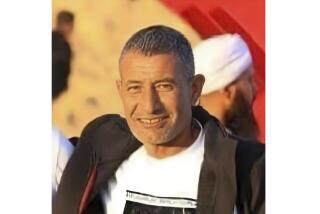Israel Demands Return of Airman Shot Down in Lebanon, Believed Held by Amal
- Share via
JERUSALEM — A senior Israeli defense official Friday demanded the return “forthwith” of an Israeli airman believed to have been captured when he bailed out of his stricken warplane over southern Lebanon on Thursday.
Uri Lubrani, the Defense Ministry’s coordinator of activities in Lebanon, said the Israeli government considers the Amal militia of the Shia Muslims to be responsible for the captive’s safety and well-being.
Lubrani was responding to reports from the Lebanese coastal city of Sidon quoting an Amal spokesman as saying that a 19-year-old militiaman had captured the airman minutes after his F-4 Phantom jet was shot down by a Soviet-made SAM-7 missile.
“The captive has a fractured arm,” the Amal spokesman was quoted as saying. “Otherwise, he is well.”
A Daring Operation
A second Israeli airman who parachuted from the aircraft managed to elude Lebanese and Palestinian guerrilla patrols in the area until he could be located by Israeli helicopter gunships sent out to find him. In a daring operation, he leaped onto the undercarriage of the helicopter and was flown to safety despite gunfire from the ground.
The rescued airman was identified as the pilot of the downed F-4, the man still missing as its navigator. Neither was identified by name.
Israeli officials said they could not confirm that the navigator is in Amal’s hands or even that he is alive. First reports from Lebanon indicated that one of the two men had been killed. Still, a high-ranking government source told The Times, “We have good reason to believe that he is alive, . . . that he is in Amal hands.”
First Lost Since 1983
The downed Phantom was the first warplane Israel has lost in Lebanon since November, 1983. It was one of an unspecified number--unofficial sources say there were 12--of Israeli aircraft that attacked what the military command described as bases of the mainstream Fatah faction of the Palestine Liberation Organization.
The raid followed by less than 24 hours a grenade attack in Jerusalem on a group of military recruits and well-wishers who had just attended a swearing-in ceremony at the Western Wall, Judaism’s holiest site. One man was killed and 70 people were wounded in this incident.
Beirut radio reported that four people were killed and 12 were wounded in the Israeli retaliation raid. Witnesses were quoted as saying that the Israeli warplanes, in three formations of four, made three bombing and rocketing runs near the Palestinian refugee camp known as Miye ou Miye, southeast of Sidon.
In Beirut, the government of Lebanese President Amin Gemayel lodged an official complaint with the United Nations, accusing Israel of “aggression and occupation” in Lebanon.
No Stone Unturned
Lubrani, the Defense Ministry official, told The Times: “Yesterday’s air force action was directed neither at Lebanon nor at Lebanese citizens, but against terrorist bases. Israel will not leave a stone unturned when the safety of one of its soldiers is at stake.”
Israeli military sources said an air and sea search for the navigator was carried out Thursday night and was continuing Friday.
The search was the largest operation of its kind in southern Lebanon since two Israeli soldiers were captured in a guerrilla ambush last February. Then, Israeli armored forces, backed by warplanes and helicopter gunships, stormed across the border in a search that was abandoned after a week. One of the soldiers is believed to have died from wounds he received in the ambush, and the other is thought to be held by Hezbollah, an extremist faction backed by Iran.
Lands in Olive Grove
Meanwhile, more details emerged about Thursday’s rescue of the pilot from the downed Phantom. Military sources said he landed in an olive grove about 50 yards from a PLO position. The Palestinians reportedly opened fire on him and chased him for several yards until he dived over the crest of a hill and rolled to safety.
The pilot hid in the underbrush and signaled to the helicopters with an electronic beeper, which is standard issue for Israeli airmen. The helicopter, flying close to the ground and dodging fire, found the pilot in a matter of minutes but could not put down because of the terrain, which is covered with undergrowth. It hovered low enough for the pilot to grasp the undercarriage, then soared away with other helicopters providing cover fire.
The rescue craft put down for a short time on the beach near Sidon, and there the pilot was lashed to the undercarriage with a rope for flight out over the water and back to the border, about 35 miles away. The helicopter ran out of fuel just as it landed in Israel.
Beeper Gives Out
Israeli sources said the navigator’s electronic beeper did not function for long enough for the helicopter rescue teams to get a fix on it.
Rafik Ibrahim, 19, an Amal militiaman, told reporters at his native village of Zeghdraya that it was he who had captured the navigator.
“I jumped out of the bush and ordered him to stick his hands up when he landed by parachute in the olive grove yesterday,” Ibrahim was quoted as saying. “He raised only one arm. I was afraid he might have something in his other hand, so I shouted at him and gestured with my M-16 (rifle) for him to raise that other hand. He could not.”
Ibrahim said he “approached cautiously” and found that the airman’s arm was broken.
“I then marched him at gunpoint for about 1,200 yards from the valley to Zeghdraya,” he went on. “My superiors then took him somewhere else.”
More to Read
Sign up for Essential California
The most important California stories and recommendations in your inbox every morning.
You may occasionally receive promotional content from the Los Angeles Times.











